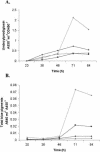Systematic insertional mutagenesis of a streptomycete genome: a link between osmoadaptation and antibiotic production
- PMID: 15078860
- PMCID: PMC479117
- DOI: 10.1101/gr.1710304
Systematic insertional mutagenesis of a streptomycete genome: a link between osmoadaptation and antibiotic production
Abstract
The model organism Streptomyces coelicolor represents a genus that produces a vast range of bioactive secondary metabolites. We describe a versatile procedure for systematic and comprehensive mutagenesis of the S. coelicolor genome. The high-throughput process relies on in vitro transposon mutagenesis of an ordered cosmid library; mutagenized cosmids with fully characterized insertions are then transferred by intergeneric conjugation into Streptomyces, where gene replacement is selected. The procedure can yield insertions in upward of 90% of genes, and its application to the entire genome is underway. The methodology could be applied to many other organisms that can receive DNA via RK2/RP4-mediated intergeneric conjugation. The system permits introduction of mutations into different genetic backgrounds and qualitative measurement of the expression of disrupted genes as demonstrated in the analysis of a hybrid histidine kinase and response regulator gene pair, osaAB, involved in osmoadaptation in Streptomyces. The independently transcribed response regulator gene, osaB, is essential for osmoadaptation; when grown with supplementary osmolyte, an osaB mutant cannot erect aerial hyphae and produces up to fivefold greater antibiotic yields than the wild-type strain.
Figures




References
-
- Bentley, S.D., Chater, K.F., Cerdeno-Tarraga, A.M., Challis, G.L., Thomson, N.R., James, K.D., Harris, D.E., Quail, M.A., Kieser, H., Harper, D., et al. 2002. Complete genome sequence of the model actinomycete Streptomyces coelicolor A3(2). Nature 417: 141-147. - PubMed
-
- Blondelet-Rouault, M.H., Weiser, J., Lebrihi, A., Branny, P., and Pernodet, J.L. 1997. Antibiotic resistance gene cassettes derived from the Ω interposon for use in E. coli and Streptomyces. Gene 190: 315-317. - PubMed
-
- Cho, Y.H., Lee, E.J., Ahn, B.E., and Roe, J.H. 2001. SigB, an RNA polymerase σ factor required for osmoprotection and proper differentiation of Streptomyces coelicolor. Mol. Microbiol. 42: 205-214. - PubMed
WEB SITE REFERENCES
-
- http://www.sanger.ac.uk/Projects/S_coelicolor/; S. coelicolor genome sequence database.
-
- http://jiio16.jic.bbsrc.ac.uk/S.coelicolor/; S. coelicolor genome sequence and mutagenesis database including cosmid sequences.
Publication types
MeSH terms
Substances
Associated data
- Actions
- Actions
Grants and funding
LinkOut - more resources
Full Text Sources
Other Literature Sources
Medical
